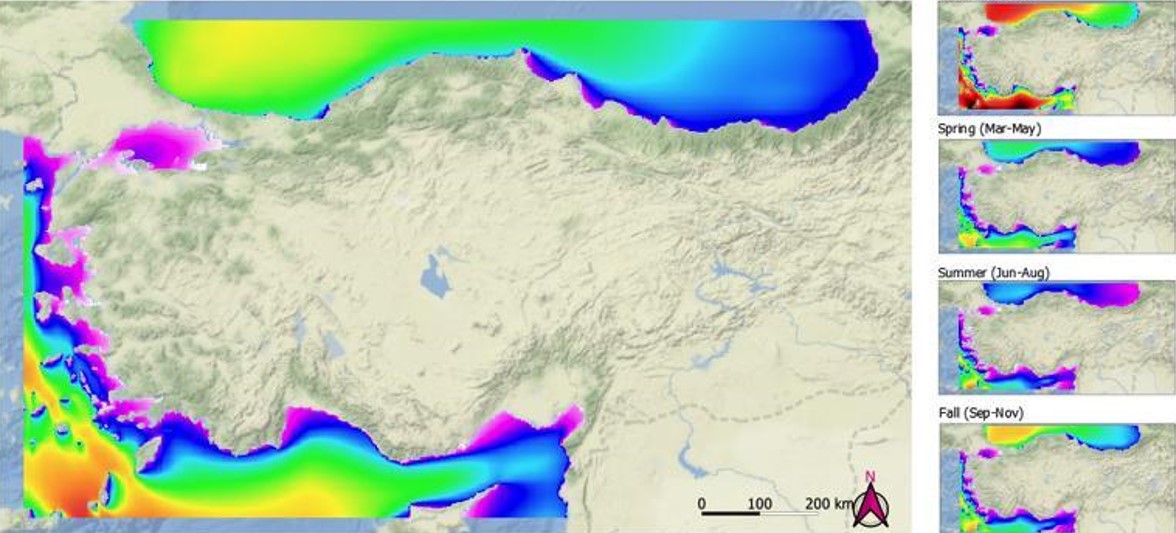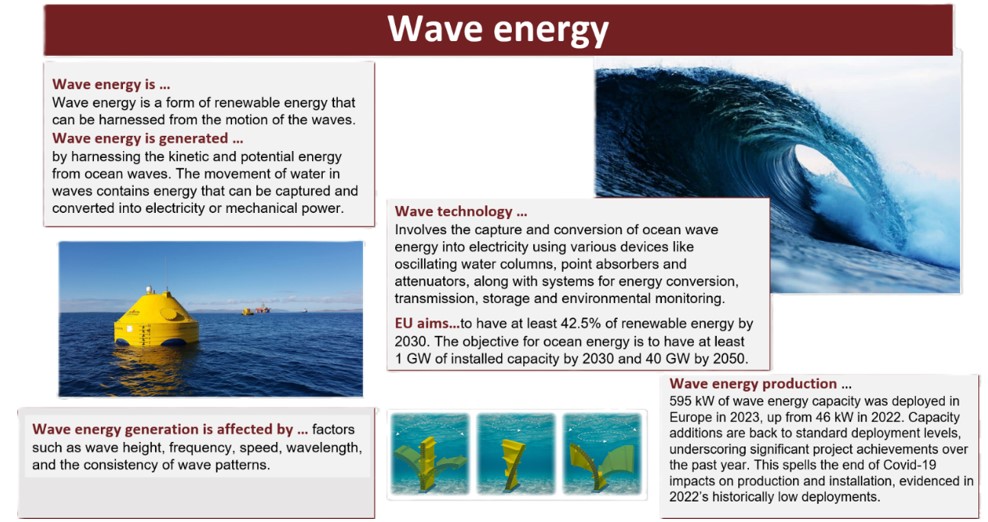- Definition and Types of Energy
- Myths And Misconceptions About Energy
- The Relationship Between Energy and Environment
- Climate Change and Carbon Footprint
- Greenhouse Gas Effect
- The Role of Human-Induced Greenhouse Gases and Energy Consumption
- Energy Efficiency and Sustainability
- Renewable Energy Sources and Future Perspectives
- Play and Learn
- Solar Energy Conversions
- Solar Energy Worldwide
- Solar Energy in Partner Countries
- Positive and Negative Impacts
- Technologies for Harnessing Solar Energy
- Solar thermal energy technologies and applications
- Electricity Generation Methods
- Passive Heating and Cooling of Residences with the Sun
- Concentrator solar power (CSP) systems and electricity generation
- Systems and Applications That Generate Electricity directly from solar rays
- Photovoltaic Cells and Panels
- Domestic PV Systems
- Off-Grid PV Systems
- Hybrid Connected Systems
- Materials Used in PV Cells
- Play and Learn
 Sea-Ocean Energy in Partner Countries
Sea-Ocean Energy in Partner Countries
Sea-Ocean Energy in Türkiye
Türkiye has significant potential in terms of sea and ocean energy. Wave energy, in particular, stands out as a significant resource in increasing our country’s energy diversity. According to measurements made in Türkiye’s seas, there is an annual technical wave energy potential of approximately 50 TWh. The regions with the highest potential are concentrated especially on the coastline between İzmir and Antalya. Therefore, the regions between Antalya and İzmir (Finike-Dalaman) are considered the most suitable places for electricity generation from wave energy. Studies have also gained momentum for offshore wind energy projects in Türkiye. A total area of 1,895.6 km² has been allocated for offshore wind energy by the Ministry of Energy and Natural Resources, including 1,111 km² off the coast of Bandırma, 299 km² off the coast of Bozcaada, 75.6 km² off the coast of Gelibolu and 410 km² on the coast of Karabiga.
According to the "Türkiye Offshore Wind Energy Roadmap" report prepared by the World Bank, there is a total technical offshore wind energy potential of 75 GW in Türkiye's territorial waters. The report predicts that 7 GW of offshore wind energy capacity can be reached by 2040. Although commercial projects related to marine energy are still limited in Türkiye, various research and experimental projects are being conducted at the academic level. In particular, in a project carried out by the Ministry of Energy and Natural Resources in 2007 on wave energy, barges were used where the vertical movement of waves was converted into electrical energy by generators, and 5 kWh of electricity was generated with this system, meeting the energy needs of two houses. As a result, various studies are being conducted by both public institutions and the private sector to evaluate Türkiye's marine and ocean energy potential. The start of technical studies on offshore wind energy projects in 2024 in particular will be an important step in terms of diversifying our country's renewable energy resources and increasing energy supply security.

Sea Ocean Energy in Portugal
Wave energy has been discussed in Portugal for over 50 years. During the 1970s, the country produced some pioneering academic work in this issue.
Excluding offshore wind farms, energy projects in this area are, by now, limited to sea wave energy for electricity production.
The country has significant potential in this field, primarily owing to its extensive western coastline of approximately 800 km, where conditions are favorable for harnessing wave energy. The “Central do Pico” project, located in Porto Cachorro, in Pico Island, Azores, was the first research and demonstration project in this area financed by the European Commission. The first studies began in 1986, with the plant operating in 1999. This was the first wave energy plant in the world to be connected to the electrical grid. The conversion process used the oscillating water column technology, producing electricity through a turbine developed in Portugal. The central was closed in 2018, and since then, there have been several attempts to reactivate it. Several wave energy projects have been implemented this century, namely in the northern (Aguçadoura) and central (Peniche) areas of the country.
Although wave energy has immense potential, some technological and structural maintenance challenges have hindered its growth, resulting in a very low total installed power capacity."
Between 2017 and 2019, an experimental system using tidal currents was installed on the southern coast. In this case, the source of energy was the river currents in an estuary. However, the potential of this resource on the Portuguese coast is very low.
The development of wave energy in Portugal is part of several national plans that are being implemented, namely the National Plan for Energy and Climate (PNEC 2030). A significant growth in this energy source is expected in the coming years.

Sea Ocean Energy in Greece
Greece possesses significant potential in the field of sea and ocean energies, with a particular focus on wave energy and offshore wind. The country's extensive coastline and favorable geographical conditions make it an ideal location for the development of marine renewable energy. Greece’s wave energy potential is particularly notable, with studies indicating an annual technical potential of approximately 35 TWh. The regions with the highest wave energy potential are primarily located along the Aegean Sea, particularly on the islands of the Cyclades, as well as the southern Peloponnese coastline. These areas are considered among the most suitable for the development of wave energy projects, offering opportunities for both electricity generation and contributing to the country’s renewable energy goals.
In addition to wave energy, offshore wind energy has gained increasing attention in Greece, with studies highlighting its significant potential. The country’s exclusive economic zone (EEZ) in the Aegean and Ionian Seas provides favorable conditions for offshore wind farms. According to the "National Renewable Energy Action Plan," Greece has a technical offshore wind energy potential of up to 22 GW. In recent years, various offshore wind energy projects have been proposed, with the government allocating areas for offshore wind farm development in the Aegean Sea. These projects are seen as crucial for meeting Greece’s ambitious renewable energy targets and enhancing energy security. The Greek government has also initiated a series of regulatory reforms to support the development of marine energy, aiming to streamline permitting processes and attract private sector investment.

While commercial projects in marine and ocean energy are still in the early stages in Greece, several research and pilot projects are underway. The country’s involvement in international collaborations and European Union-funded initiatives is helping to advance the technological development and economic feasibility of sea energy. In particular, the Ministry of Environment and Energy has been supporting a range of studies focused on the environmental impacts and technological innovations needed to harness wave and offshore wind energy efficiently. Looking ahead, Greece aims to expand its marine energy capacity significantly over the next two decades, making it a key component of the country’s transition to a more sustainable and diversified energy system.
In conclusion, Greece is well-positioned to capitalize on its sea and ocean energy potential, particularly through the development of wave and offshore wind energy. With ongoing research, regulatory support, and investment in innovative technologies, Greece is expected to play a prominent role in the advancement of marine renewable energy in the Mediterranean region, contributing to both national and regional energy sustainability.
Sea Ocean Energy in North Macedonia
Since North Macedonia is a landlocked country, it does not have direct access to sea or ocean energy sources such as wave, tidal, or offshore wind energy. As a result, there are currently no marine energy projects, research initiatives, or infrastructure developments related to sea and ocean energy within the country. The country's renewable energy efforts are instead focused on hydropower, solar, wind, and geothermal resources.
While North Macedonia does not have the geographical characteristics to exploit sea-based energy sources, it is actively developing its renewable energy sector through substantial investments in wind and solar power. These efforts are aimed at diversifying the country's energy mix, enhancing energy security, and contributing to environmental sustainability